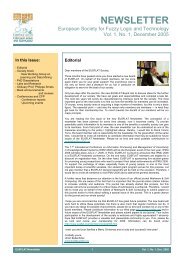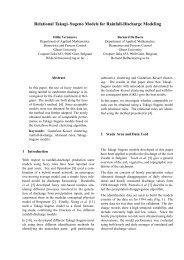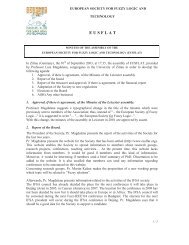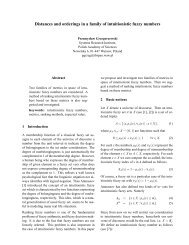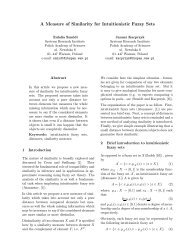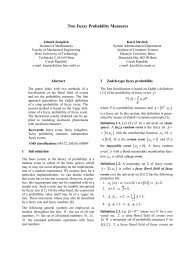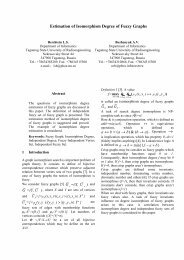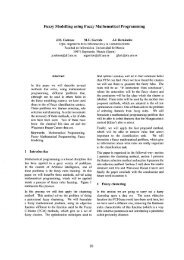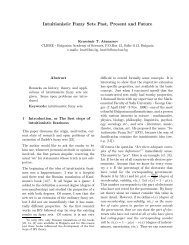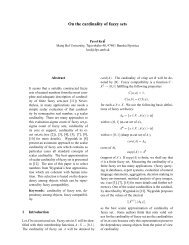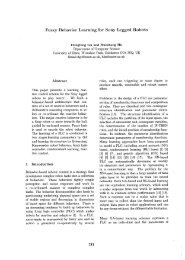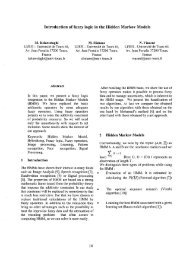KM-Fuzzy Approach Space - EUSFLAT
KM-Fuzzy Approach Space - EUSFLAT
KM-Fuzzy Approach Space - EUSFLAT
Create successful ePaper yourself
Turn your PDF publications into a flip-book with our unique Google optimized e-Paper software.
FA5. F(x,A,t + s) ≥ F(x,A (r) ,t), ifs> r ≥ 0,<br />
F(x,A,+∞) ≥ F(x,A (+∞) ,t),<br />
where A (r) = {y ∈ X : F(y,A,t)=1,∀t > r},<br />
and A (+∞) = {y ∈ X : F(y,A,+∞)=1};<br />
FA6. F(x,A,·): [0,+∞) → [0,1] is left-continuous for all x ∈<br />
X and A ⊂ X.<br />
The map F is symmetric (or the FA-space (X,F) is symmetric)<br />
if<br />
F(x,{y},t)=F(y,{x},t) for all x,y ∈ X, t > 0.<br />
Firstly, we will prove that there are two families of spaces<br />
satisfying the above six properties.<br />
Lemma 2.2 (A-space ↩→ FA-space) Let (X,δ) be an Aspace.<br />
If we define a fuzzy set Fδ on X × P (X) × [0,+∞] as<br />
follows:<br />
Fδ (x,A,t)=0 if t ≤ δ(x,A),<br />
Fδ (x,A,t)=1 if t > δ(x,A),<br />
then (X,F δ) is a FA-space.<br />
Proof. FA1, FA2 and FA3 are immediate. In order to<br />
prove FA4, if A,B ⊆ X we can suppose min(δ(x,A),δ(x,B)) =<br />
δ(x,A) ≤ δ(x,B) and, then max(F(x,A,t),F(x,B,t)) =<br />
F(x,A,t). Thus Fδ (x,A ∪ B,t) =0 for t ≤ δ(x,A); and<br />
Fδ (x,A ∪ B,t) =1 for t > δ(x,A). This completes the proof<br />
of FA4.<br />
For every r ∈ [0,+∞), the set A (r) is the same in A-space<br />
and in FA-space, since<br />
A (r)<br />
A−space = x ∈ X δ(x,A) ≤ r <br />
= x ∈ X Fδ (x,A,t)=1,∀t > r = A (r)<br />
FA−space .<br />
Let us suppose that s > r. Since δ(x,A) ≤ δ(x,A (r) )+r, thus<br />
for t ≤ δ(x,A) − s, wehave<br />
t + r < t + s ≤ δ(x,A) ≤ δ(x,A (r) )+r;<br />
i.e., t < δ(x,A (r) ) and F δ(x,A,t + s)=F δ(x,A (r) ,t)=0 for t +<br />
s ≤ δ(x,A).<br />
Otherwise, if t + s > δ(x,A), then F δ(x,A,t + s) =1 ≥<br />
F δ(x,A (r) ,t). This completes the proof.<br />
Theorem 2.3 (FM-space ↩→ FA-space) Let (X,M,∗) be a<br />
FM-space. If we define a fuzzy set F on X × P (X) × [0,+∞]<br />
for every x ∈ X, t ∈ [0,∞] and A ⊆ X as follows:<br />
FM (x,A,t)=sup M (x,a,t),<br />
a∈A<br />
then (X,FM) is a FA-space.<br />
Proof. By FM1 and FM2, conditions FA1 and FA3 hold.<br />
The proof of the second condition FA2 follows from the<br />
definition of supA for empty sets, sup/0 = 0. If x ∈ X and<br />
A,B ⊆ X are subsets of X, then<br />
Max<br />
<br />
sup M (x,a,t), sup M (x,b,t)<br />
a∈A<br />
b∈B<br />
ISBN: 978-989-95079-6-8<br />
<br />
IFSA-<strong>EUSFLAT</strong> 2009<br />
= sup M (x,a,t).<br />
a∈A∪B<br />
Consequently FA4 is proved.<br />
We will prove now FA5. Let x ∈ X, A ∈ P (X) and r ∈ [0,∞].<br />
If A = /0, the condition FA5 is trivial. It is enough to prove that<br />
the property FA5 holds true for every A = /0. Since, for every<br />
x,y,z ∈ X, t,s > 0<br />
in particular,<br />
M(x,z,t + s) ≥ M(x,y,t) ∗ M(y,z,s);<br />
M(x,y,t + s) ≥ M(x,a,t) ∗ M(a,y,s)<br />
for every x ∈ X, a ∈ A (r) , y ∈ A, t > 0,s > r ≥ 0.<br />
Taking supremum over y ∈ A, then<br />
FM (x,A,t + s)=sup M (x,y,t + s)<br />
y∈A<br />
≥ M(x,a,t) ∗ sup M(a,y,s)<br />
y∈A<br />
= M(x,a,t) ∗ FM(a,A,s).<br />
Since, a ∈ A (r) , then FM(a,A,s)=1 for s > r. Thus<br />
FM (x,A,t + s) ≥ M(x,a,t).<br />
Taking supremum over a ∈ A (r) ,wehave<br />
FM (x,A,t + s) ≥ FM(x,A (r) ,t).<br />
Note that additionally the following condition is satisfied:<br />
FA7 Let x,y ∈ X be such that FM (x,{y},t)=1 for every t > 0,<br />
then x = y.<br />
3 Characterization<br />
Now we ask about the maps F : X × P (X) × [0,+∞] → [0,1]<br />
that could provide to X of a FA-space structure. In this cases,<br />
it could be interesting to weaken axioms FA4 and FA5.<br />
Proposition 3.1 Let X be a non-empty set, F : X × P (X) ×<br />
[0,+∞] → [0,1] be a map satisfying axiom FA2 and such that<br />
F (x,A,t)=1 for every t > 0 and x ∈ A ⊆ X. Then:<br />
The axiom FA4 is equivalent to<br />
FA4 ′ . F (x,A ∪ B,t) ≥ Max(F (x,A,t),F (x,B,t)) for t > 0,<br />
for every non-empty subsets A,B ⊆ X such that A = B<br />
and A ∪ B ⊂ X, and for each x ∈ X\(A ∪ B).<br />
The axiom FA5 is equivalent to<br />
FA5 ′ . F(x,A,t +s) ≥ F(x,A (r) ,t) for t > 0, for every s > r ≥<br />
0, /0 = A ⊂ X and for each x ∈ X\A.<br />
Proof. We prove that there exists some cases in which FA4<br />
and FA5 are always true.<br />
Property FA4 ′ .IfA is empty, then F (x,A ∪ B,t)=F (x,B,t)<br />
and, by the axiom FA2<br />
Max(F (x,A,t),F (x,B,t)) = Max(F (x, /0,t),F (x,B,t))<br />
= Max(0,F (x,B,t)) = F (x,B,t).<br />
A similar conclusion is valid for B = /0. We will suppose that<br />
A and B are non-empty sets. If x ∈ A ∪ B, then, by hypothesis,<br />
F (x,A ∪ B,t)=1 ≥ Max(F (x,A,t),F (x,B,t)).<br />
1703



